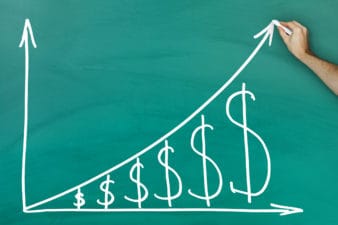Getting your TFSA to $1,000,000 is a good goal for retirement, and it’s not an unreasonable one either, so long as you build your savings and have investments that can earn above-average yields. It’s definitely not easy, but it is attainable. Below, I’ll show you an example as to how it could be possible if you have $50,000 saved up today,
Bank stocks are safe, but not necessarily optimal
For many investors, holding shares of a bank stock like Toronto-Dominion Bank (TSX:TD)(NYSE:TD) is seen as the safe and reliable way to grow their savings. And while it’s true that TD stock is a great option for risk-averse investors, and it’s likely to continue rising over the years, the returns that it has generated in recent years wouldn’t make it optimal to do so, unless you have a lot of investing years left.
Consider that over five years, TD stock has risen about 40% for an average increase of about 7% per year. However, those returns are also during very good economic times when the marks have been performing very well. TD’s stock has significantly underperformed both the Dow Jones, which has risen close to 60% during that time, and the NASDAQ, which has been up around 80%.
While we can certainly throw TD’s dividend into the mix, which, if we round up to 4%, would make those average returns about 11%. Even at 11% per year, with compounding, over five years the returns would be about 68%. That’s above the Dow Jones but still below the NASDAQ. TD has produced good returns for investors, but they haven’t been great, and better options could be available if investors are willing to take on some risk.
Why a growth stock is key
A good example of a stock that has achieved a lot of growth is Shopify (TSX:SHOP)(NYSE:SHOP). While finding the next Shopify, the next stock that can produce approximate 1,000% returns over five years would be a tall task on its own, it isn’t necessary to achieve better returns than TD’s.
For example, let’s assume that Shopify’s return is still high, but a more modest 15% per year going forward. Even for other growth stocks, that’s within the realm of possibilities, although it certainly isn’t a risk-free rate of return. We’ve seen in the past how Shopify can be prone to shocks to its share price.
At a rate of 15%, returns over five years would double and come in higher than the NASDAQ. It’s not a whole lot higher than TD’s combined 11% returns, but it makes a big difference. Here’s how your portfolio could look if you had $50,000 growing at a rate of 15% per year:
| Year | Portfolio |
| 1 | $57,500.00 |
| 2 | $66,125.00 |
| 3 | $76,043.75 |
| 4 | $87,450.31 |
| 5 | $100,567.86 |
| 6 | $115,653.04 |
| 7 | $133,000.99 |
| 8 | $152,951.14 |
| 9 | $175,893.81 |
| 10 | $202,277.89 |
| 11 | $232,619.57 |
| 12 | $267,512.51 |
| 13 | $307,639.38 |
| 14 | $353,785.29 |
| 15 | $406,853.08 |
| 16 | $467,881.04 |
| 17 | $538,063.20 |
| 18 | $618,772.68 |
| 19 | $711,588.58 |
| 20 | $818,326.87 |
| 21 | $941,075.90 |
| 22 | $1,082,237.29 |
By the end of year 22, your portfolio would be able to reach $1,000,000. That’s with investing in a growth stock with much weaker returns than Shopify’s. Going with a stock like TD instead and averaging 11% would take an additional seven years, 29 in total, to reach the same $1,000,000 mark.
Bottom line
If you have a lot of investing years left, then TD could be the better choice for investors, and it’ll certainly be a safer option. However, if that’s not the case, investors may be better of going with a growth stock to help increase their portfolio’s returns, as even a 4% difference could accelerate your portfolio’s growth significantly.
 2-for1 Sale
2-for1 Sale







